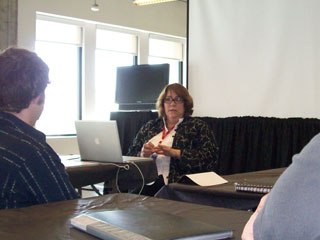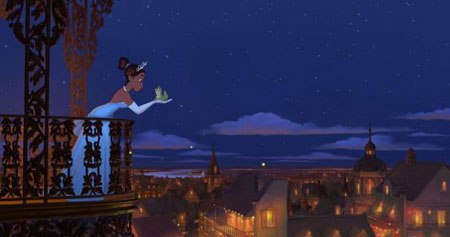Joe Strike reports on Disney's increased presence at Red Stick, coinciding with the holiday release of the nearby New Orleans-themed Princess and the Frog.
Baton Rouge's Red Stick International Animation Festival has set a high bar (or stick) for itself. Its fifth go-round just concluded, the festival serves several purposes: promoting the city as a digital media center; letting aspiring writers, producers and artists rub shoulders with industry professionals; introducing local students to the joys of animation and CG vfx work; and naturally making a name for itself as a world class animation gathering.
How are these goals coming along? Quite nicely. This year's programming covered a range of creative, business and technical topics, from advice on "monetizing" new media content to career counseling and deconstruction of high-end vfx work. It seemed like almost every school in town had a class visiting the festival, with students filling the seats at many of the sessions.
The ratio of industry professionals to eager young talent was surprisingly low. Baton Rouge is off the beaten path, a bit of a distance away from New York, Hollywood and other places where future animation talent tends to congregate; it might be worth a student, or even a self-taught artist the price of a Baton Rouge plane ticket to have one-on-one face time with Disney talent scouts, feature animation producers and vfx celebrities. (Of course, there's also the small matter of meals and lodging while you're in town, but four-plus to a hotel room and pizza deliveries are s.o.p. at the average sci-fi/pop-culture convention and shouldn't be ruled out by potential future Red Stick attendees.)
Speaking of Disney, that venerable studio was once again well-represented at the festival. Doeri Welch-Greiner, associate producer of the studio's recent Glago's Guest CG short and production manager of the upcoming Rapunzel feature made her first Red Stick appearance at the suggestion of higher-ups who asked her to join the studio's sizeable festival contingent to talk about 2D and 3D pipelines and look at portfolios. "I showed Glago and talked through the behind-the-scenes and 'making of' bits, then we screened it again so they could watch it with those things in mind. It turned people onto the idea there are more CGI jobs than just animator."
Although Doeri talked about a specific need for character TDs, "people thinking about things like cloth and hair that are so hard to do," she added that "in spite of the amount of specialization people need to have, the pendulum is swinging back to a real team structure where you want people who are rock stars at what they do but also have enough foundational knowledge of the people on the handing off and receiving ends of their job, so they can work as a tightly knit team rather than one department handing off to another and never interacting again.
"The rigger does his best to put in everything the animator wants, but it takes 150 feet of animation before the animator realizes [the character] doesn't have quite exactly what he needs. We're trying to set up a structure where there are character teams and sequence teams so we can acknowledge the way films are really made instead of focusing on streamlining the manufacturing process.
"I reviewed dozens of portfolios from a lot of students, especially Louisiana students from ITT [a local technical college offering graphic design and digital media courses]. There are definitely some students who are going to be submitting their stuff for our summer intern program and winter artistic associates programs."
Doeri is one of several people I talked to at the festival who refer to "feet" of animation. "Visual effects people talk about frames," she admitted, "but we're still using antiquated feet. It's not an excellent measure, five feet equals approximately three seconds, but it's kind of our general measuring stick. It doesn't make a lot of sense, but we've used for so long…"
The biggest Disney name on hand might have been Mark Henn (The Princess and the Frog, Mulan, Aladdin, Beauty and the Beast, The Little Mermaid), who snagged the festival's second Lifetime Career Achievement award, but the one who got the most attention was Marlon West, The Princess and the Frog's effects supervisor. The main audience for his Friday warm-up session was an auditorium filled with bussed-in school kids who learned about West's career path. After going from independent features (Bebe's Kids, Rover Dangerfield) to working on every Disney 2D film from The Lion King to Home on the Range, West joined the CG revolution: "I stopped drawing, picked up a mouse and started using a keyboard" when he began working with Maya and Houdini software. When John Lasseter took over Disney animation and decided to resurrect 2D production, West said he felt like the male equivalent of Helen Hunt in Cast Away when his old love returned: "I have a new wife now and her name is Maya."
The topic of the supposed floating word "SEX" subliminally slipped into The Lion King came up; West insisted its sighting was the result of peoples' imagination, but when an audience member repeated a rumor the letters actually spelled out "SFX" and were put in by the effects department, West reaction's was, "That's a good story, I'll have to use it. I've also heard the word was really 'SOX' -- put there by a Chicago White Sox fan."
Later in the day West returned for Red Stick's most anticipated event, The Princess and the Frog sneak peek (Disney's first 2D film in six years). We were only shown a portion of the work in progress, in its story reel/rough animation stage with only a few cleaned-up, effects-added shots. (At the closing awards dinner the following night, Henn remarked there were still 37 scenes to complete within the next six weeks.)
West began by revealing a bit more about what set him on the road to animation: a photograph of stop-motion pioneer Willis O'Brien setting up a shot for the silent movie version of Arthur Conan Doyle's The Lost World; to his childish eyes "it was a picture of a grown man at home playing with toys." He went on to compare effects that add production value ("smoke, fire, water -- we don't pay to see them, but the movie looks flat without them") vs. effects that are there as part of the story and drive the scene. ("That's when the effects are on 'Front Street;' we call them 'music room' scenes.")
West screened animation of villain Dr. Facilier shuffling his deck of tarot cards, then showed footage that won't be part of the finished film: effects-heavy shots of James, the soon-to-be frog trapped in two snakes' coils and pinned to his chair while Facilier casts his spell on him. "It made the scene more about the effects than showing what's going on." The snakes got the boot, and instead the film depicts James' silhouette inside a swirling green fog, growing slightly smaller before switching to a POV shot from his perspective of Facilier looking down into the camera and seeming to grow taller by the second...
The next sequence was an expanded version of the one shown at January's Disney/Red Stick press conference of Princess Tiana and the frog's first meeting. The scene was played for laughs, with the frog coming across Pepé Le Pew-vein even as his moist froginess grosses out Tiana. After their fateful kiss Tiana vanishes inside her dress as she shrinks to frog size. Just as with James, her transformation goes unseen, but is revealed to her -- and the audience -- via another POV shot when she sees herself in a conveniently nearby mirror. (Interestingly enough, a variety of other scenes that were screened in January were not presented this time around.)
West gave props to Pixar for their influence on the production. Echoing some of Doeri's themes, he said the crew was encouraged to "think of ourselves as part of the process, as artists working on a much more collaborative basis and the directors [John Musker and Ron Clements] open to other opinions. It's a cultural change: everyone wants to make a great film and not just worry about their own slice."
West described The Princess and the Frog as "old school, with only 2D camera moves" and its digital effects avoiding "3D pyrotechnics." In spite of the film's release pushed up to Thanksgiving from Christmas, "it has to be just as beautiful… while the importance of characters may have changed and we considered different ideas for the climax, the basic story always stayed the same: Tiana has a not-human adventure and falls in love without knowing what that person really looks like." Letting the attendees in on some behind-the-scenes intrigue, West said that while Pixar's Ed Catmull and Musker were strongly behind the film and Ron and John had a strong idea of what they wanted to do, "some people across the street weren't so strong on it. We screened the film every 12 weeks for the last year-and-a- half at the studio. Pixar's motto is 'be wrong early.'"
By sending such high profile talents as Welch-Greiner and West, Disney might be laying the local foundation for the New Orleans-set film's Thanksgiving release. Then again, the studio had a serious presence at the festival last year as well. It might be Red Stick's trajectory toward becoming the pre-eminent U.S. animation festival, or Disney viewing the festival as fertile ground for future talent, but no matter the reason, Disney has made a serious commitment to Red Stick.
The animation industry's participation in Red Stick has always been impressive, but the festival needs to increase its ground-level attendance; sessions that should have attracted larger audiences barely had more than a handful of people show up; more outreach to animation schools might be one approach.
Another approach may have been revealed in the full page ad for next year's Red Stick that appeared in an issue of The Hollywood Reporter distributed at the festival: 2010's Red Stick will feature "The American Animation Market: It's a great alternative to MIPTV. STAY in the U.S."
Joe Strike is a regular contributor to AWN. His animation articles also appear in the NY Daily News and the New York Press.











